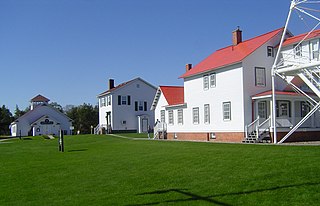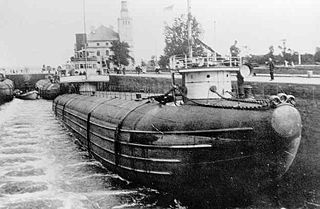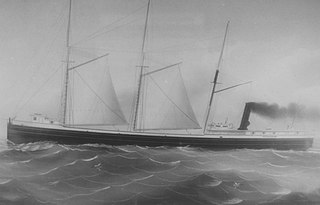
The PS Lady Elgin was a wooden-hulled sidewheel steamship that sank in Lake Michigan off the fledgling town of Port Clinton, Illinois, whose geography is now divided between Highland Park and Highwood, Illinois, after she was rammed in a gale by the schooner Augusta in the early hours of September 8, 1860. The passenger manifest was lost with the collision, but the sinking of Lady Elgin resulted in the loss of about 300 lives in what was called "one of the greatest marine horrors on record". Four years after the disaster, a new rule required sailing vessels to carry running lights. The Lady Elgin disaster remains the greatest loss of life on open water in the history of the Great Lakes.

Whitefish Bay is a large bay on the eastern end of Lake Superior between Michigan, United States, and Ontario, Canada. It is located between Whitefish Point in Michigan and Whiskey Point along the more rugged, largely wilderness Canadian Shield of Ontario. The international border runs through the bay, which is heavily used by shipping traffic northbound from and southbound to the Soo Locks.

The Great Lakes Shipwreck Museum is located at the Whitefish Point Light Station 11 miles (18 km) north of Paradise in Chippewa County in the U.S. state of Michigan. The light station property was transferred to the Great Lakes Shipwreck Historical Society (GLSHS), the Michigan Audubon Society (MAS), and the United States Fish and Wildlife Service (USFWS) in 1996. The three entities share governance of the site. The museum is operated by the GLSHS. The museum exhibits artifacts from shipwrecks from the Whitefish Point Underwater Preserve and the bell from the wreck of the SS Edmund Fitzgerald. Admission to the museum includes a tour of historic buildings with displays that interpret the Great Lakes maritime, United States Coast Guard, and US Life-Saving Service history.

Whitefish Point is a cape of Michigan's Upper Peninsula, United States, marking the entry point of Whitefish Bay. It is 11 miles (18 km) north of the unincorporated community of Paradise, Michigan.

The Whitefish Point Light is a lighthouse located in Chippewa County in the U.S. state of Michigan. Located on the southeastern shores of Lake Superior, it sits at the edge of Whitefish Point leading to Whitefish Bay. Constructed in 1849, it is the oldest operating lighthouse in the Upper Peninsula. All vessels entering or exiting Lake Superior pass near Whitefish Point. The area is infamously known as the "Graveyard of the Great Lakes" due to the high number of shipwrecks in the area, most famously the SS Edmund Fitzgerald.

The Thomas Wilson was a whaleback freighter built in 1892 and used to haul bulk freight on the Great Lakes. The ship sank in Lake Superior just outside the harbor of Duluth, Minnesota, United States, on 7 June 1902, after a collision with the George Hadley. The wreck of the Thomas Wilson is one of the best remaining examples of a whaleback steamer, and it is also significant for the changes made in operating procedures at the Duluth harbor. The remains of the ship were listed on the National Register of Historic Places in 1992.

The Whitefish Point Underwater Preserve was established in 1987 to protect and conserve shipwrecks and historical resources on 376 square miles (970 km2) of Lake Superior bottomlands in Whitefish Bay and around Whitefish Point, Michigan. The formation of the Michigan Underwater Preserves helped stop controversy over artifact removal from shipwrecks of this area. The preserve is now known for deep, well preserved shipwrecks in clear water accessible to scuba divers with technical skill and experience. The preserve is one of the last places in the Great Lakes to observe shipwrecks without zebra mussel encrustation.

SS Comet was a steamship that operated on the Great Lakes. Comet was built in 1857 as a wooden-hulled propeller-driven cargo vessel that was soon adapted to carry passengers. She suffered a series of maritime accidents prior to her final sinking in 1875 causing the loss of ten lives. She became known as the only treasure ship of Lake Superior because she carried 70 tons of Montana silver ore when she sank. The first attempts to salvage her cargo in 1876 and 1938 were unsuccessful. Comet was finally salvaged in the 1980s when the Great Lakes Shipwreck Historical Society illegally removed artifacts from the wreck. The artifacts are now the property of the State of Michigan and are on display as a loan to the Great Lakes Shipwreck Museum. The fate of her silver ore cargo is unknown. Comet's wreck is now protected by the Whitefish Point Underwater Preserve as part of an underwater museum.

The John M. Osborn was a wooden steam barge that sank in Lake Superior in 1884 with the loss of five lives. The Osborn was just 2 years old when the larger, steel-hulled Alberta, which was called a "steel monster" and "terror of the lakes", rammed her. The wreck of the Osborn was discovered 100 years after her sinking. The wreck was illegally salvaged in the 1980s. Many of Osborn's artifacts became the property of the State of Michigan after they were seized from Great Lakes Shipwreck Museum. The State allows the museum to display the artifacts as a loan. The wreck of the Osborn is now protected by the Whitefish Point Underwater Preserve as part of an underwater museum.

The SS Vienna was built in 1873 during the era when steamers were built with sail rigging. She had a 19 year career marked with maritime incidents including sinking when she was just 3 years old. She sank for her final time in fair weather in Whitefish Bay in Lake Superior after she received a mortal blow when she was inexplicably rammed by the steamer Nipigon. Although no lives were lost when the Vienna sank for the last time, more than 100 years later her wreck claimed the lives of 4 scuba divers, the most of all the wrecks in the Whitefish Point Underwater Preserve that now protects her as part of an underwater museum. Her wreck was stripped of artifacts that resulted in the Michigan Department of Natural Resources seizing her artifacts in a raid on the Great Lakes Shipwreck Museum in 1992. Her artifacts are now on display in this museum as loan from the State of Michigan.

The SS Samuel Mather (1887) was the first of seven U.S. merchant ships to bear that name. The wooden Mather sank in 1891 after she was rammed by the steel freighter Brazil in heavy fog in Whitefish Bay 8 miles (13 km) from Point Iroquois, ending the Mather's 4-year career. Her intact wreck is a rare of example of wooden freighters that plied the Great Lakes and she is a popular scuba diving site. Although there was no loss of life when the Mather sank, her wreck claimed the lives of three scuba divers more than 100 years after she sank. Artifacts from her wreck were illegally removed in the 1980s by the Great Lakes Shipwreck Historical Society. The artifacts are now the property of the State of Michigan and are on display as a loan to the Great Lakes Shipwreck Museum. The wreck of the Mather is protected as part of an underwater museum in the Whitefish Point Underwater Preserve.

SS John B. Cowle (1902) was one of the early Great Lakes bulk freighters known as "tin pans". She was the first of two ships named for prominent Cleveland, Ohio citizen and shipbuilder John Beswick Cowle. In 1909 on her maiden voyage SS Isaac M. Scott rammed John B. Cowle in heavy fog off Whitefish Point. John B. Cowle sank in three minutes, taking 14 of her 24-man crew with her. Artifacts from her wreck were illegally removed in the 1980s. Her artifacts are now the property of the State of Michigan and are on display as a loan to the Great Lakes Shipwreck Museum. The wreck of John B. Cowle is protected as part of an underwater museum in the Whitefish Point Underwater Preserve.

The Sagamore is reported to be the best example of a whaleback barge among Great Lakes shipwrecks. Only 44 whalebacks were ever built, and out of the 26 that sank, only 8 sank in the Great Lakes, most of them being blown up for blocking shipping channels. She sank in 1901 in the shipping lane near the Soo Locks when she was rammed by the steel steamer Northern Queen in one of Whitefish Bay's notorious fogs. Her captain and two crew members went down with her. Artifacts from her wreck were illegally removed in the 1980s. Her artifacts are now the property of the State of Michigan and are on display as a loan to the Great Lakes Shipwreck Museum. The wreck of the Sagamore is protected as part of an underwater museum in the Whitefish Point Underwater Preserve.

The SS M.M. Drake was a wooden steam barge that towed consorts loaded with coal and iron ore on the Great Lakes. She came to the rescue of the crews of at least 4 foundering vessels in her 19 year career only to meet the same fate in her final rescue attempt. Drake sank in 1901 off Vermilion Point after a rescue attempt of her consort Michigan. Her rudder, anchor, and windlass were illegally removed from her wreck site in the 1980s. They are now the property of the State of Michigan. The rudder is on display as a loan to the Great Lakes Shipwreck Museum and the anchor and windlass are on loan for display to Whitefish Township Community Center. The wreck of Drake is protected as part of an underwater museum in the Whitefish Point Underwater Preserve.

SS Myron was a wooden steamship built in 1888. She spent her 31-year career as lumber hooker, towing schooner barges on the Great Lakes. She sank in 1919, in a Lake Superior November gale. All of her 17 crew members were killed but her captain survived. He was found drifting on wreckage near Ile Parisienne. Her tow, the Miztec, survived. Myron defied the adage that Lake Superior "seldom gives up her dead" when all 17 crewmembers were found frozen to death wearing their life jackets. Local residents chopped eight of Myron's sailors from the ice on the shore of Whitefish Bay and buried them at the Mission Hill Cemetery in Bay Mills Township, Michigan.

The Miztec was built as a 3-masted schooner in 1890. She was later converted to a schooner barge and served as a consort for lumber hookers on the Great Lakes. She escaped destruction in a severe 1919 storm that sank her longtime companion, the SS Myron, only to sink on the traditional day of bad luck, Friday the 13th, 1921, with the loss of all hands. She came to rest on Lake Superior's bottom off Whitefish Point near the Myron.

Algoma was a screw steamer built in 1883. She sank off Mott Island near Isle Royale in Lake Superior in 1885 and some of her remains are still on the lake bottom. The wreck was placed on the National Register of Historic Places in 1984.

SS Choctaw was a steel-hulled American freighter in service between 1892 and 1915, on the Great Lakes of North America. She was a so-called monitor vessel, containing elements of traditional lake freighters and the whaleback ships designed by Alexander McDougall. Choctaw was built in 1892 by the Cleveland Shipbuilding Company in Cleveland, Ohio, and was originally owned by the Lake Superior Iron Company. She was sold to the Cleveland-Cliffs Iron Company in 1894 and spent the rest of her working life with it. On her regular route between Detroit, Escanaba, Marquette, and Cleveland, she carried iron ore downbound, and coal upbound.

SS Russia was an iron-hulled American Great Lakes package freighter that sank in a Lake Huron gale on April 30, 1909, near DeTour Village, Michigan, with all 22 of her crew and one passenger surviving.

SS John Mitchell was a steel-hulled, American lake freighter in service between 1907 and 1911. She was built in 1906 by the Great Lakes Engineering Works in St. Clair, Michigan, for the Cornell Steamship Company of Chicago, Illinois, which was managed by C.W. Elphicke. She entered service in 1907, and had a sister ship named William B. Davock. Throughout her career, John Mitchell carried iron ore and coal. On October 4, 1908, she ran aground at Indiana Harbor, Indiana, while loaded with iron ore.



















